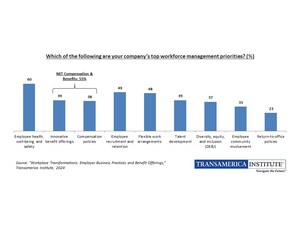LOS ANGELES, June 8, 2021 /PRNewswire/ -- Seventy percent of employers have been negatively impacted by the coronavirus pandemic and more than half (54 percent) have implemented cost-cutting measures that affected their employees, according to Navigating the Pandemic: A Survey of U.S. Employers, a report released today by nonprofit Transamerica Institute® and its Transamerica Center for Retirement Studies® (TCRS). The report is based on a survey of more than 1,900 employers conducted in late 2020 and contains an analysis by company size, including small (less than 100 employees), medium (100 to 499 employees), and large for-profit companies (500 or more employees).
"Amid the pandemic, employers have been navigating a public health crisis, a turbulent economy, financial woes, and difficult business decisions. However, they are also finding ways to support their employees during this challenging time," said Catherine Collinson, CEO and president of Transamerica Institute and TCRS.
Nine in 10 employers (90 percent) implemented one or more types of support for their employees during the pandemic, according to the survey findings.
"As employers recover and envision the post-pandemic workplace, they have the opportunity to enhance their benefit offerings. The benefits marketplace is highly competitive, and employers may find new solutions within their reach. As a specific example, recent legislation has made it easier and more affordable for small businesses to start offering a retirement plan," said Collinson.
Employee Benefits: A Win-Win for Employers and Employees
A competitive employee benefits package is often a win-win situation in the workplace. It can help employers attract and retain talent while providing their employees with the ability to save for retirement and protect their health and financial well-being.
Larger companies are more likely to have robust benefits than small companies, but there is ample room for growth among companies of all sizes. According to the survey findings:
- Retirement benefits. Fifty-two percent of employers offer a 401(k) or similar employee-funded retirement plan to their employees. These plans are much more commonly offered by large (90 percent) and medium companies (83 percent), compared with fewer than half of small companies (44 percent) that do so.
- Health insurance and other benefits. Health insurance (57 percent) is an often-cited benefit, followed by life insurance (33 percent), employee assistance program (29 percent), and disability insurance (27 percent). Larger companies are more likely to offer these benefits. For example, more than eight in 10 large (82 percent) and medium companies (84 percent) offer health insurance, compared with about half of small companies (51 percent).
- Workplace wellness programs. Employees can get support in maintaining good health, while employers can potentially lower health insurance costs. Twenty-four percent of employers offer a program, including large (55 percent), medium (39 percent), and small companies (18 percent).
- Caregiver support. Many employees are likely to face the need to balance their work responsibilities with caregiving for an aging parent or loved one. Six in 10 employers (60 percent) offer one or more programs to support caregiving employees, including large (95 percent), medium (87 percent), and small companies (52 percent). However, much more can be done by employers of all sizes. Only about one in five employers offer online resources and/or tools to support caregivers (23 percent), an employee assistance program (22 percent), training for managers (20 percent), and/or a benefit that offers referrals to backup care (18 percent).
A Call to Action
"Employers play a vital societal role by providing employment, employee benefits, and the ability for workers to save and invest for a secure retirement. Especially now, as our nation emerges from the pandemic, employers need support from policymakers to continue paving the way for their recovery and to make it as easy as possible to modernize their business practices and expand their benefits offerings," said Collinson.
Navigating the Pandemic: A Survey of U.S. Employers includes a survey report with in-depth findings about health and welfare, workplace wellness, and retirement benefits, as well as a shorter fact sheet. Transamerica Institute has also done extensive work on age-friendly workplaces. Recently, in collaboration with Johns Hopkins Bloomberg School of Public Health, Transamerica Institute published Workplace Wellness: What is the Value on Investment for Diabetes and Hypertension Programs at the Workplace?, including a white paper and an employer guide. Visit www.transamericainstitute.org. Follow on Twitter @TI_insights.
About Transamerica Institute®
Transamerica Institute® is a nonprofit, private foundation dedicated to identifying, researching, and educating the public about retirement security and the intersections of health and financial well-being. It is the parent organization of Transamerica Center for Retirement Studies® which conducts one of the largest and longest-running annual retirement surveys of its kind. Transamerica Institute is funded by contributions from Transamerica Life Insurance Company and its affiliates and may receive funds from unaffiliated third parties. The information provided here is for educational purposes only and should not be construed as insurance, securities, ERISA, tax, investment, legal, medical, or financial advice or guidance. Please consult independent professionals for answers to your specific questions. www.transamericainstitute.org
About the Survey
The analysis contained in Navigating the Pandemic: A Survey of U.S. Employers was prepared internally by the research team at Transamerica Institute. A 25-minute, online survey was conducted from November 18 to December 20, 2020 among a nationally representative sample of 1,903 employers by The Harris Poll on behalf of nonprofit Transamerica Institute. Potential respondents were targeted based on job title at for-profit companies and met the following criteria: Business executives with specific titles who make decisions about employee benefits at their company, and the company employs at least one full-time employee across all locations. Quotas were set by company size and results were statistically weighted as needed by using targets from the Dun & Bradstreet database to ensure the results are representative. In order to ensure that this sample is fully representative of the targeted universe of employers, results were weighted by company size, annual revenue, industry and region.
Media Contact:
Andrew Cook
[email protected]
614-330-5898
SOURCE Transamerica Institute
Related Links
WANT YOUR COMPANY'S NEWS FEATURED ON PRNEWSWIRE.COM?
Newsrooms &
Influencers
Digital Media
Outlets
Journalists
Opted In





Share this article